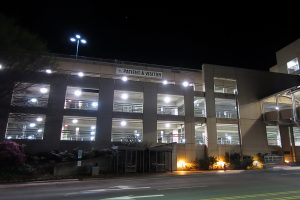
UNC Health Care patients and campus visitors parking in the Dogwood Parking Deck on Manning Drive will notice that the lighting throughout the deck is now brighter and whiter. Facilities Services recently completed a comprehensive upgrade of the deck’s lighting systems, replacing the high pressure sodium fixtures in the deck with new energy efficient LED (Light-Emitting Diode) lighting.
The Dogwood Parking Deck was selected for LED retrofitting by UNC Transportation and Parking under their 2011-2016 Five-Year Plan. After observing significant energy savings from the LED-lit Bell Tower Parking Deck after it opened in fall 2010, Transportation and Parking saw the opportunity for further reducing costs and increasing operating efficiencies by converting the lighting systems in existing parking decks as well. Keith Snead and Greg Graves, the Facilities Services design and construction managers on the Dogwood Deck project, report that converting the deck to LED lighting is projected to save the University approximately $50,000 annually, an almost 70 percent reduction in energy costs.
LED lighting is already installed in more than 30 University buildings and is used for site lighting across campus. Snead and Graves said LED lights offer numerous benefits over the high pressure sodium lamps that have historically been used in the University’s parking decks:
- LED systems require less power to operate and are extremely energy efficient.
- Average LED lamp life is 50,000 hours compared to 30,000 hours for sodium lights.
- With an average life of 100,000 hours, LED drivers last twice as long as sodium light ballasts.
- Longer lamp and service life reduces maintenance and service calls.
- LED lamps burn brighter and whiter, improving security and visibility.
- LED lights light instantaneously and do not require a “warm-up” period like sodium lamps.
Snead said that when Facilities Services first sought approval for the project, the State Construction Office was not convinced that retrofitting the deck with LED lights would be cost effective. Facilities Services conducted a life cycle analysis for the parking structure, comparing three types of lighting systems: high pressure sodium, metal halide and LED. Although initial costs for installing LED lighting are higher than for other types of fixtures, the long-term energy and maintenance savings proved to make it the more cost effective choice.
Facilities Services converted nearly 700 fixtures in the Dogwood Deck from high pressure sodium to LED. They also installed 35 solar powered LED pole light fixtures along the top level of the deck, the first installation of its kind on campus.
As part of Transportation and Parking’s 2017-2022 Five-Year Plan, four more parking decks will be converted to LED lighting: Rams Head, Jackson Circle, Cobb and the Business School Parking Deck. Converting these and other buildings to high efficiency lighting is one of many ways the University is looking to further reduce campus energy consumption in support of the Three Zeros Initiative. Launched in fall 2016, the initiative calls for reducing the University’s environmental footprint through three sustainability goals: net zero water usage, zero waste to landfills, and net zero greenhouse gas emissions. The University has pledged to become greenhouse gas neutral by 2050.
